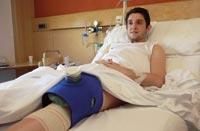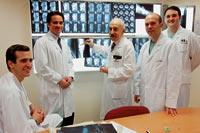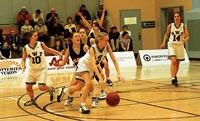Radio waves to heal the knee
2005/05/01 Kortabitarte Egiguren, Irati - Elhuyar Zientzia Iturria: Elhuyar aldizkaria
The use of radiofrequency and two-pole heat in cross knee ligament injuries is effective in 90% of cases, in addition to accelerating patient recovery. This technique has been applied by specialists from the Department of Orthopedic Surgery and Traumatology of the University Clinic of the University of Navarra, so they have obtained the National Award of Research in Sports Medicine organized by the University of Oviedo.

According to this study, the radiofrequency of two poles and the heat generated by the treatment itself must be used to strain the ligament whenever it is not broken. For starters, heat is applied to the ligament that is 'given' on a given radio frequency. Then, with the advances of technology, the ligament contracts and finally stretches or at least returns to the initial situation. That is, say, the ‘path’ that the injured ligament makes. The first step, ligament shrinkage, can be easily explained by a clear example. What happens when we slice into a heated skillet? Having a lot of water and fiber contracts. Ligaments also have a high content of water fiber and collagen, which contract and stretch by applying heat to a radiofrequency determined to the ligament that is given.
This technique is also applied through arthroscopy, so it is a minor intervention. Recovery with this treatment is much faster and there are many options for the result to be satisfactory, of course if the treatment is applied correctly. Treatment is appropriate for people with partial ligament injury or with the 'given' ligament, as it tightens the ligament again and allows sports in three months.
If the ligament is broken no
The research work was carried out with thirty athletes in treatment at the University Clinic of Navarra. The Department of Orthopedic Surgery and Traumatology has collaborated with the Department of Radiology, since after the intervention, magnetic resonance patients were monitored for at least one year. Of these, 90% obtained good results, the rest recovered with conventional techniques, but it took longer. It also seems that treatment is more appropriate for people who play sports usually in their leisure time or for adults, as well as for veteran athletes with affected knees.

But let us not forget that the treatment does not serve for cases of cross ligament rupture. The next step should be to respond to this, since no one doubts that the rupture of the anterior cruciate ligament is a serious and habitual injury. Footballers and skiers are the most suffering, but it is also common in other sports where the knee is subjected to torsions, twists and violent contacts.
Rupture of the ligament can cause an interruption of the athlete between six and eight months; in addition, if the ligament breaks completely, surgery must be applied and the break must be completed with a piece of another ligament or tendon. Then it hardens for several months and a new anterior cruciate ligament is formed.
More injuries in women. Why?
It is true that women athletes break more knee ligament than men, and scientists have discovered reason. The female legs are more straight and that can be the cause of more injuries.

After several trials, researchers discover that when women jump their knees they are more together and straight. As proof, they were asked to run in various ways and pass through a platform and measured their strength in different directions. Then they realized that women make more torsion force with their knees.
Sudden collapse of the knee or excessive pressure can break the anterior cruciate ligament. This type of injury is almost eight times more common in women than in men, such as basketball, football and volleyball.
However, there are numerous hypotheses about this. In fact, the menstrual cycle has also been used to explain the greater frequency of such injuries in women. During the menstrual cycle, in addition to being altered hormones, ligaments are generally calmer. This, among other things, increases the risk of injury, especially in days near ovulation.




